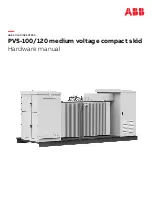
6
sensoren mit magnetischer Sonde erfaßt und in eine propor-
tionale Spannung gewandelt:
U I
V
I
A
U I
V
I
A
1
1
3
3
3
10
3
10
( )
[ ]
=
⋅
[ ]
( )
[ ]
=
⋅
[ ]
Die Messung des Stromes erfolgt nur an zwei Ausgängen,
da in einem symmetrischen Drehstromnetz damit auch der
dritte Strom bekannt ist. Denn es gilt: I
1
+ I
2
+ I
3
= 0
bt
Umrichter-Ausgang Phase 3; Anschluß W der Drehstromma-
schine.
bu
Umrichter-Ausgang Phase 2; Anschluß V der Drehstromma-
schine.
cl
Umrichter-Ausgang Phase 1; Anschluß U der Drehstromma-
schine.
cm
Der Motorfilter wird eingesetzt zur Reduzierung der Flanken-
steilheit der gepulsten Ausgangsspannung des Umrichters
von ursprünglich 2000 V /
m
s auf Werte < 250 V /
m
s. Dies
wirkt sich günstig auf die Spannungsüberhöhung auf langen
Motorleitungen aus, schont die Isolierungen und vor allem
reduziert es die feld- und leitungsgebundene Störabstrah-
lung.
cn
Der eigentliche Inverter mit sechs IGBT, schnellen Inversdi-
oden, Gate Drive- und Schutz-Logik ist in einem sogenann-
ten “Intelligenten Power Modul” integriert.
Grenzdaten der Brücke:
Max Kollektor-Emitter-Spannung U
CES
= 600 V
max. Kollektor Strom I
C
= 15 A
TypischeSchaltzeiten:
t
ON
= 0,6
m
s
t
OFF
= 2,0
m
s
max. PWM-Frequenz: 20 kHz
Durchlaßeigenschaften IGBT und Diode:
Sättigungsspannung bei I
C
= 30 A
U
CE(sat)
= typ. 1,8 V (max 2,5 V)
Schleusenspannung Diode bei –IC = 15 A
– U
CE
= typ. 2,5 V (max. 3,5 V)
Für einem Spitzenwert des Kollektorstromes von I
C
= 30 A
ergibt sich bei sinusförmigem Strom rechnerisch ein maxi-
maler Effektivwert von 21 A. Wegen der überlagerten Strom-
oberwellen und des begrenzten Stromes des speisenden
einphasigen Netzes (16 A) muß der maximale Daueraus-
gangsstrom mit 8 A festgelegt werden.
co
Schaltzustandanzeige der sechs Leistungstransistoren.
Siehe.
bp
cp
Minuspol der Zwischenkreisspannung. Keine Erd- und Kurz-
schlußfähigkeit.
cq
Collektor des Choppertransistors, Anschluß für externen
Chopperwiderstand
cr
Freilaufdiode des exter nen Bremswiderstand.
cs
Plus-Pol der Zwischenkreisspannung, Anschluß für exter-
nen Chopperwiderstand. Keine Erd- und Kurzschlußfähig-
keit.
ct
Interner Bremswiderstand 20 k
W
und Anschlußmöglichkeit
für einen externen Bremswiderstand. Der eingebaute Chop-
perwiderstand ist nicht in der Lage nennenswerte Bremsen-
ergie aufzunehmen. Er ist nur gedacht als Hilfe beim Oszil-
loskopieren der Chopperfunktion. Wird die Bremsfunktion
benötigt, so ist ein externer Bremswiderstand von 100
W
par-
allel zu dem 20 k
W
Widerstand, also zwischen den Kollektor
des Bremstransistors
cr
und den Pluspol der Zwischen-
kreisspannung
cs
anzuschließen. Ist der Bremswiderstand
nicht vorhanden, so kann es bei Bremsvorgängen zum
Schutz des Umrichters zu einer Abschaltung kommen.
compensation-current sensors with magnetic probes and
conver ted into a proportional voltage:
U I
V
I
A
U I
V
I
A
1
1
3
3
3
10
3
10
( )
[ ]
=
⋅
[ ]
( )
[ ]
=
⋅
[ ]
The measurement of the current is only performed at two
outputs, since in a symmetrical three-phase mains the third
current is then also known. This is because the following
applies: I
1
+ I
2
+ I
3
= 0
bt
Conver ter output phase 3; terminal W of the three-phase
machine.
bu
Conver ter output phase 2; terminal V of the three-phase
machine.
cl
Conver ter output phase 1; terminal U of the three-phase
machine.
cm
The motor filter is used to reduce the steepness of slope of
the pulsed output voltage of the converter from the original
2000 V /
m
s to values < 250 V /
m
s. This has a positive effect
on the excess voltage on long motor leads, spares the insu-
lation and above all reduces the field and line-bound distur-
bance radiation.
cn
The actual inverter with six IGBTs, fast-acting inverting di-
odes, gate drive and protective logic circuitry has been inte-
grated into a so-called “Intelligent Power Module”.
Limiting data of the bridge:
Max. collector-emitter voltage U
CES
= 600 V
Max. collector current I
C
= 15 A
Typical switching times:
t
ON
= 0.6
m
s
t
OFF
= 2.0
m
s
max. PWM frequency: 20 kHz
Forward characteristics IGBT and diode:
Saturation voltage for I
C
= 30 A
U
CE(sat)
= typical 1.8 V (max.2.5 V)
Threshold voltage for diode with –IC = 15 A
– U
CE
= typical 2.5 V (max. 3.5 V)
When we have a peak value of the collector current of I
C
=
30 A, the mathematical result in the case of a sinusoidal
current is a maximum rms value of 21 A. Due to the super-
imposed current harmonics and the limited current of the
feeding single-phase mains (16 A), the maximum continu-
ous output current must be restricted to 8 A.
co
Switching status indicator of the six power transistors.
See
bp
cp
Negative pole of the link voltage. No earth-fault and short-
circuit proof capacity.
cq
Collector of the chopper transistor, connection for external
chopper resistor
cr
Free-wheeling diode of the external brake resistor.
cs
Positive pole of the link voltage, connection for external
chopper resistor. No earth-fault or short-circuit proof capaci-
ty.
ct
Internal brake resistor 20 k
W
and connection possibility for
an external brake resistor. The built-in chopper resistor can-
not absorb any considerable brake energy. It is only thought
of as an aid to help display the chopper function on the os-
cilloscope. If the brake function is needed, then an external
brake resistor of 100
W
has to be connected in parallel to
the 20 k
W
resistor, i.e. between the collector of the brake
transistor
cr
and the positive pole of the link voltage
cs
. If

























